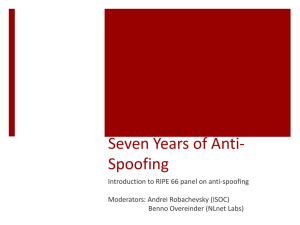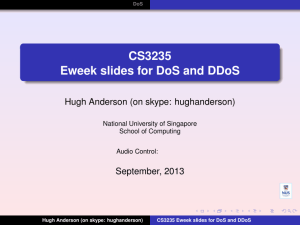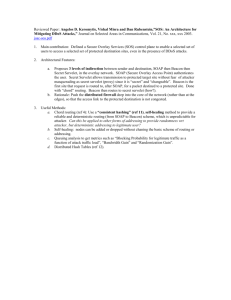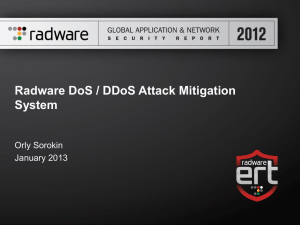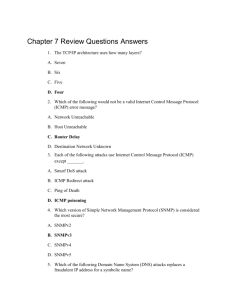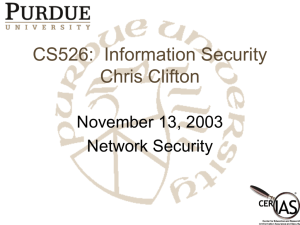cs526 research project
advertisement
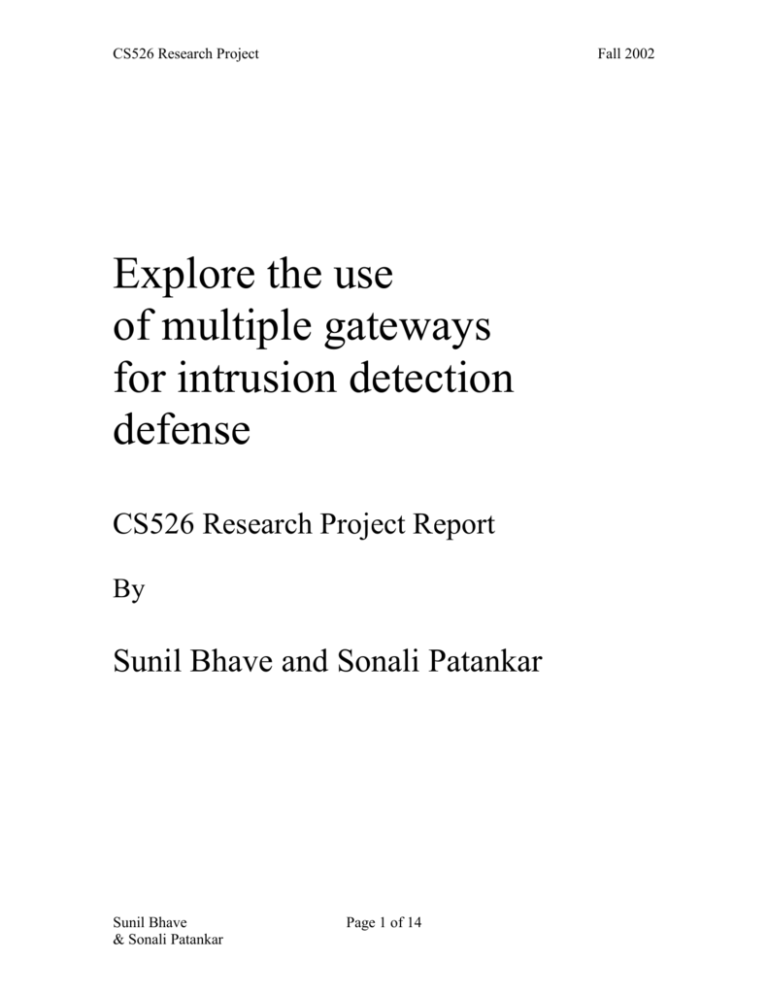
CS526 Research Project Fall 2002 Explore the use of multiple gateways for intrusion detection defense CS526 Research Project Report By Sunil Bhave and Sonali Patankar Sunil Bhave & Sonali Patankar Page 1 of 14 CS526 Research Project Fall 2002 Table of Contents Introduction ......................................................................................................................... 3 DOS................................................................................................................................. 4 Typical Attack ................................................................................................................. 4 Misconecptions about DOS ................................................................................................ 5 Prevention Techniques ........................................................................................................ 6 Preventing personal computers from being used as a DDoS host .................................. 7 Attack recovery ................................................................................................................... 9 Countermeasures ............................................................................................................... 10 Using Mutliple Gateways ................................................................................................. 12 Conclusion ........................................................................................................................ 13 Resources and References................................................................................................. 14 Sunil Bhave & Sonali Patankar Page 2 of 14 CS526 Research Project Fall 2002 Introduction The purpose of this report is to introduce ideas for intrusion detection defense, and explore possibility of using multiple gateways to aid in this effort. Since the reader of this document may or may not be familiar with DOS or DDOS, we will also provide an introduction on this subject. Network Security is an area, which, more we explore; more we get amazed to what can be achieved. Achievements are looked at different perspectives, based on what one wants to do. In the context of this document, we may say that attacker to a network achieves his goals of bringing the victim site to its knees. In terms of the people, who are trying to provide protection to such kind of attacks, try to achieve their goal, by trying to overcome as many possibilities there can be for the attacks. In our opinion, both the communities are important. Attacker is not important because he brings the intended computers to halt, but because of this, everyone is getting aware about the shortcomings of the current technology we are using, and what areas are insecure. Attack prevention community is trying everything it can to find out where the vulnerabilities are and try to close as many routes as they can, for attackers. We intend to provide some ideas and practices for allowing intrusion prevention by the way of this document. We have also tried to provide information about how the intrusion protection community is teaming up and getting people to know more about DOS. Sunil Bhave & Sonali Patankar Page 3 of 14 CS526 Research Project Fall 2002 DOS Denial of Service (DoS) is an attack designed to render a computer or network incapable of providing normal services. The most common DoS attacks will target the computer's network bandwidth or connectivity. Bandwidth attacks flood the network with such a high volume of traffic, that all available network resources are consumed and legitimate user requests cannot get through. Connectivity attacks flood a computer with such a high volume of connection requests, that all available operating system resources are consumed, and the computer can no longer process legitimate user requests. A Distributed Denial of Service (DDoS) attack uses many computers to launch a coordinated DoS attack against one or more targets. Using client/server technology, the perpetrator is able to multiply the effectiveness of the Denial of Service significantly by harnessing the resources of multiple unwitting accomplice computers, which serve as attack platforms. Typically a DDoS master program is installed on one computer using a stolen account. The master program, at a designated time, then communicates to any number of "agent" programs, installed on computers anywhere on the internet. The agents, when they receive the command, initiate the attack. Using client/server technology, the master program can initiate hundreds or even thousands of agent programs within seconds. Typical Attack A website DDoS is executed by flooding one or more of the site's web servers with so many requests that it becomes unavailable for normal use. If an innocent user makes normal page requests during a DDoS attack, the requests may fail completely, or the pages may download so slowly as to make the website unusable. DDoS attacks typically take advantage of several computers which simultaneously launch hundreds of thousands of requests at the target website. In order not to be traced, the perpetrators will break into unsecured computers on the internet, hide rogue DDoS programs on them, and then use them as unwitting accomplices to anonymously launch the attack. Sunil Bhave & Sonali Patankar Page 4 of 14 CS526 Research Project Fall 2002 Misconceptions about DOS On the surface, DOS looks very clear, but since ways of attacks can be so many, in reality DOS can get quite complicated. This complication creates many misconceptions about DOS. Firewall is a system that sits between the router that connects to outside world and the main organization infrastructure. Firewalls are rule-based systems, which allow or disallow certain type of traffic. A lot of people think that having a firewall, is protecting their system from DDOS attack or in other words, they don’t need IDS.A firewall helps but in often cases may not detect or prevent an attack. Examples from research use a bridge building scenario to help understand effectiveness of firewall. Any builder when building the first bridge is overcautious and will use more materials than needed, just to make sure that bridge wont collapse. After that the risk taking starts and the standard sometime drops down to such a level, that a bridge built does collapse. Then suddenly the overcautious phase starts and so on. When relating this to a firewall, to begin with you may have strict rules for your firewall. But soon you start noticing that, being so strict, it will be very difficult to make any useful business, so you go and relax the restrictions a little bit and so on. In this phase you may experience an attack, which may put you back on alert state again. Also though, firewalls can prevent certain type of traffic, they cant do the dynamic analysis of packets that IDS systems can do, to detect or prevent an attack. Another popular misconception out there, is that, if my system is not protected with firewall and/or IDS any thing that will go wrong, will be only with my system, I can not hurt other system. DDOS attacks have proven that a system can be compromised as an agent or a victim if its not protected properly. Sunil Bhave & Sonali Patankar Page 5 of 14 CS526 Research Project Fall 2002 Prevention Techniques The best mitigation strategy against any attack is if the attack never occurs. Research in intrusion prevention has stressed the importance of a well-defined security policy. Another approach to prevent DDoS attack is to stop the attack traffic before it reaches the victim as presented by research on Ingress and Egress filtering. “A security policy defines the set of laws, rules, and practices that regulate how an organization implements, manages, protects, and distributes computing resources to achieve security objectives.” Security policies help organizations to define the type of DDoS and other threats they choose to guard against and to incorporate various advisories to prevent these threats. Many DDoS tools alter the source IP addresses of attack packets to illegitimate addresses in the Internet name space such as “0.4.7.28”. Tracing of the attack source will indicate the illegitimate IP address and the firewall therefore ineffectively blocks a nonexistent address. Alternatively, the source addresses of the attack packets can be changed to that of a victim’s so that the real victim will be identified as the attacker. By tracing and blocking the source IP of such spoofed packets, the DDoS mitigation network essentially denies service to the real victim and achieves the denial of service that the master attacker intends. IP spoofing has made it impossible to track down the attack source. Research on ingress and egress filtering has targeted this “feature” of DDoS tool and presented an effective way to limit the damage created by such DDoS attack. In egress filtering, network routers will only route packets with addresses from its own assigned IP addresses space to the Internet. Ingress filtering denies all traffic with addresses nonconforming to the Internet Address space from entering a network. A router implementing ingress filtering can also restrict transit traffic that originates from a downstream network to known prefixes. Therefore, ingress and egress filtering can intercept an attack packet with an illegitimate source IP address; discard the packet; and thereby preventing the attack packet from reaching the Internet and the victim network. If an attack is originated from a legitimate network, ingress filtering will not be able to filter out attack packets. However, since attackers are forced to use addresses from real networks, filtering can, at the minimum, expedite packet tracing and enable quick identification of attack agents. While egress filtering can be effectively implemented by many companies or organizations, it becomes difficult or almost impossible for major service providers to take advantage of such technique. These service providers frequently need to forward Sunil Bhave & Sonali Patankar Page 6 of 14 CS526 Research Project Fall 2002 legitimate traffic that is not part of its own address space. Egress filtering also becomes extremely complicated in situations where alternate routes are used for traffic traversing through various major service providers. Nonetheless, ingress and egress filtering are fairly effective ways to prevent DDoS attack based on spoofed IP when the techniques are deployed close to the end user community. In addition following are the real life situations, which demand consideration Unless special measures have been taken, internet servers have host names and IP addresses that can be easily looked up by anyone on the internet. Many organizations do not put firewalls in front of their internet servers, leaving them largely unprotected from many of the probes and attacks that firewalls can easily stop. By default, servers listen for service requests on standard, well-known ports, and they naturally attempt to process all requests. Servers are designed to run unattended, so there is rarely a "user" present who could look for unusual activity. Servers often need to be administered remotely, from off-site, so they are designed to accept remote connections from users with very powerful permissions. Many servers will reboot automatically after a shutdown, which is exactly what certain types of exploits are looking for. Preventing personal computers from being used as a DDoS host Following are some security measures that can be used. Personal computers with full-time connections to the internet are particularly useful to DDoS perpetrators. The easiest way and most common way to compromise a personal computer is through a voluntary file download initiated by the user - malicious programs posing as screen savers, games, and images are common culprits. The sophistication of the new personal computer operating systems (e.g., Windows 98, Windows NT Workstation, Linux) which enable background processing and multi-processing, make them viable agents for distributed denial of service attacks. If your system has already been compromised, then backup the file system, reinstall the operating system and restore the file system. Install operating system updates provided by OS vendor. If the update is security-related, then it is especially crucial to install it. Sunil Bhave & Sonali Patankar Page 7 of 14 CS526 Research Project Fall 2002 Secure the clients/personal computers. All internet users on your network, particularly those with fulltime internet connections, must be informed that their computers could be used as attack agents, and they must be equipped with the latest detection software. The new anti-virus updates are now able to detect many rogue DDoS programs. The latest versions of these programs must be downloaded and installed. Sunil Bhave & Sonali Patankar Page 8 of 14 CS526 Research Project Fall 2002 Attack recovery If your system has already been compromised, then backup the file system, re-install the operating system and restore the file system. Install operating system updates provided by OS vendor. If the update is security-related, then it is especially crucial to install it. Be sure to read the vendor's documentation carefully. Some updates are less well tested than others, and an update can actually harm your system if it contains defects. Secure the servers. Turn off all unnecessary server services. Many of the services offered by your operating system are not required by your web server, for example RPC-based services. Adopt the attitude of "deny first, then allow". Assume a service should be turned off, unless it is absolutely required. First determine which of the program-based services can be turned off, such as FTP, telnet, etc. These services are easily found as executable programs in the file system. Many systems have been compromised by exploitation of buffer overrun bugs in the RPC services "statd", "cmsd" and "ttdbserverd". Check your operating system's documentation to see if it is providing services at the kernel level, which are not visible as separate programs. For example, the netmask service may be provided at the kernel level. In this case, determine what parameters can be set, if any, to turn off kernel level services that are not required. Contact your operating system vendor to find out if there are additional kernel level services that are not in the system documentation, and, if so, how to disable them. Once all unnecessary services have been disabled, make cryptographic checksums of the entire system, which can be used later if there has been a suspected breach. Configure the web server software. Verify that you have the latest version of the web server software installed. If your version is old, get the new one and install it before continuing. Turn off all unnecessary services offered by your web server software. For example, Java support, CGI support, and Server-side Script support should be turned off if they are not required. Limit physical access to the server. Take appropriate action to ensure that the server is only accessible to the designated system administrator(s). All the security in the world can be defeated by a simple floppy disk if the perpetrator has physical access to the server. Sunil Bhave & Sonali Patankar Page 9 of 14 CS526 Research Project Fall 2002 Countermeasures There is no quick and easy way to secure against a DDOS attack. From a simplistic perspective, the best solution is to secure computers from being hijacked and used as attack platforms. This cuts the problem off before it can ever manifest. Thus many experts suggest that we "pull together as a community" to secure our internet computers from becoming unwitting accomplices to such malicious intruders. Unfortunately, for every business that has the knowledge, budget, and inclination to make such changes, there are many more which lack such resources. Plus, the attackers are most likely going to use non-commercial computers as attack platforms, because they are usually easier to break into. University systems are a favorite, because they are often understaffed or the systems are set to minimum security levels to allow students to explore the systems as part of their education. Further, this is not just a national problem. Any internet server in the world could be used as an attack platform. Still, the simplest and most effective solution for preventing DDoS is through a global cooperative effort to secure the internet. The first step in the process, therefore, is concerned with scanning your internet computers to make sure they are not being used as unwitting DDoS attack platforms. This is not just good internet citizenry, however, because this also serves to document and verify that your internet computers are not suspect when DDoS attacks occur. Password security - Password security is very important. Before an attacker can launch an attack, he has to do a lot of groundwork. One of them is hacking the password on the systems he intends to use as agents for attack. Often times with cryptanalysis techniques the password can be stolen with the user of the password not being aware about it. This has got great implications when issue comes to how easily your system can be compromised to and agent or a victim. Operating system quotas – When an agent is being used for attack, the attacker is running processes on the agent which are run as server or root processes. Sometimes hackers can get successful, in not letting them show up. By putting some quota system, we can limit the processes run by root at some limit. This is not necessary foolproof but allows some control on the number of processes that a hacker may run. Firewall- Even though firewall is not sufficient to defend DoS attacks, it certainly is a good first line of defense. With its usage , we can reduce the number of problems we need to take care. Often times , it is suggested to use multiple levels of firewalls, in order to plug any holes left open by a firewall system. Sunil Bhave & Sonali Patankar Page 10 of 14 CS526 Research Project Fall 2002 IDS – Intrustion Detection Systems such as Snort play a major role in identifying the attacks which pass through many security measures we can take. Snort is a public domain freely available software and it is based on a plugin architecture. Depending on the circumstances, client can devise tools, if not already offered by Snort, to suit the situation. Many companies are coming out with commercial products also claiming to provide protection against DOS. As this field evolves, we will see more development. Sunil Bhave & Sonali Patankar Page 11 of 14 CS526 Research Project Fall 2002 Using Multiple Gateways The original goal of this project was to explore the idea of using multiple gateways in order to defend an intrusion attack. Gateways in an attack path are the ones that actually passed the packet to its end destination. In an ideal world all routers will be configured for ingress and egress filtering, and probability of an attack would be low and that of catching an attacker would be high. But the very idea that gateways touch the packets in their journey, makes us think that they should be able to provide us with some valuable information. One of the techniques called traceback can provide little help. In this technique, routers will send a message to the source IP addresses about the packets the router is processing for it. In case where a system is compromised and receives such a message, an IDS can help figure out whether the flow of packets that’s being processed by the router is legitimate or not. Another technique suggested in the research is of pushback. This concept uses multiple routers to control an attack. Often times there are more than two or more routers connected to the main router of the organization. As soon as the IDS detects that the system is under attack, the router gets overloaded with huge traffic and starts dropping packets. This huge traffic is going to contain both legitimate traffic and attack traffic, but a larger portion of the traffic is going to be attack traffic. Since the router is going to drop the packets anyway, it would be better if the neighbor router, who sent the message to main router, can drop it. For this to happen, some communication needs to take place between the router telling the router to drop all the traffic for given destination IP address. Source address could be a better way of blocking such traffic on earlier routers, but because of IP spoofing, and random source IP addresses, it may not be so efficient. This way, the main router will now be less congested and hopefully be able to serve more legitimate traffic. Although sometimes the incoming traffic may be so random, that this technique will still not relieve the congestion. The dilemma here is that we want to drop attack traffic and serve legitimate traffic. One thing to note is that even though all the incoming capacity is being used, outgoing capacity is still available. In such cases, we can have another server carrying out same functionality as the main web server, and shift those requests, which seem to be legitimate traffic to that server. Using the Virtual IP address concept that server will fulfill the request for the legitimate client. Sunil Bhave & Sonali Patankar Page 12 of 14 CS526 Research Project Fall 2002 Conclusion DDos is a very important area in network security arena. With this report we hope to provide an introduction to the subject area, tools and techniques to defend such attacks and also new ideas in order to help make the IDS systems more robust and intelligent. A lot of development is expected to happen in this subject area and all the players such as entities which operate systems on internet, equipment makers, administrator community all need to do their part to reap fruits of all the effort. Snort is an effort that must be supported and made technical contributions to. Although it probably is impossible to completely eliminate DDOS attacks, a lot can be done to minimize the damage done by it. Even now, awareness about DDOS is not high enough as it should be. Research has shown that most of the users, using low speed connections to internet are usually not used to launch an attack. Anything more than a T1 line can be an easy consideration for a hacker to create havoc on internet. Lot of education also needs to happen, to help the Anti-DDOS effort. Sunil Bhave & Sonali Patankar Page 13 of 14 CS526 Research Project Fall 2002 Resources and References The Center for Education and Research in Information Assurance and Security (www.cerias.purdue.edu) provides information on vulnerabilities and patches. CERT Coordination Center has extensive information, including alerts, information on vulnerabilities, patches, and so on, at the organization's Web site, www.cert.org. The Web site for the International Computer Security Association includes links to resources, a firewall policy guide, and some free tools at www.icsa.net. Information Systems Security Association (www.issa.org) is a professional association with links for training, resources, tools, patches, anti-virus solutions, and so on. The SANS Institute (www.sans.org) publishes vulnerabilities, resources for training, and tips for hardening operating systems. It also has training programs. Security Focus provides tools and a technically oriented digest of vulnerabilities in the Bugtraq section at www.securityfocus.com. Dave Dittrich at the University of Washington has done some exceptional work in analyzing hacker Distributed Denial of Service (DDoS) tools. His papers can be found at www.washington.edu/People/dad/. Technotronic.com has a section on DoS attacks at www.technolotronic.com/denial.html with basic information on security and DoS topics. Sunil Bhave & Sonali Patankar Page 14 of 14


